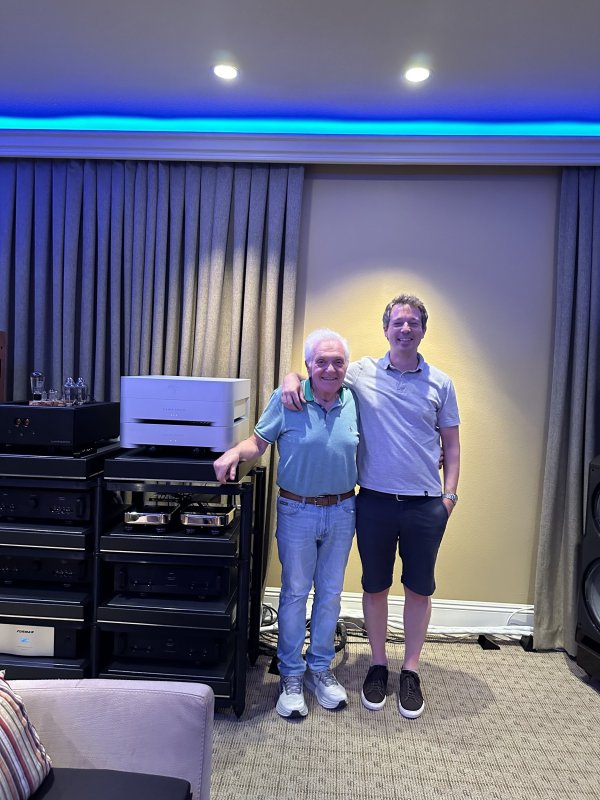THE BIG REVEAL
THE TAIKO AUDIO OLYMPUS/IO AMBASSADOR TRAVELING TOUR-STOP NUMBER ONE
This has been a simply wonderful past 4 days and one more to go. Friday I got notice that my Olympus/IO was on the truck and out for delivery. On Saturday evening after my Olympus and IO was unpacked , set up on my CMS platform Emile reached out to me and said that mine was to be the first combination in the field and that he was going to share a little secret with me. It was his incredible idea and with a sense of pride that he was starting an "ambassador tour" of members who owned the Olympus and IO and the Taiko traveling ambassador was to be none other than Christoph (tsaett), the General Manager of Taiko.I was truly surprised by Emile's comment but the staggering reality was when I woke up early Sunday morning and opened my text messages and the first was from Emile who had a big smiley on the message which simply stated ,"surprise, Chris arrives tonight 945 PM at LAX. Emile said it's late so he will probably get a hotel. I was gobsmacked and said, no friggin way will Chris travel on a 14 hour flight and find a hotel room . I said adamantly, I will be there myself to pick him up and bring him home where he will be my guest.
And so the die was cast. Chris, whom I had never met, but with whom I had. exchanged so many messages and emails over the previous several months found me immediately in the long line of people awaiting arrival of friends and relatives. We didn't make it home until about midnight but had a wonderful talk about all things Taiko and I have to say that Emile and team Taiko are fortunate to have such a wonderful young man to represent the company and I was flattered that I was the first stop on this Ambassador Tour. My understanding is that Chris has plans to be stopping on the East coast and also in Hong Kong to listen to these new Taiko systems in the field
Chris has been a wealth of information for me in helping fine tune the Olympus and Io. He has a keen sense of hearing and a fresh set of ears have always been welcome by me to offer advice.We have been listening now since Sunday and in between I have been showing Chris some of the fun places in Southern California. Yesterday after an earl morning listening session we hopped into my car and drove to the coasr where we had lunch right on the water at one of the best restaurants in the marina in Dana Point. After lunch we walked the marina trying to decide which yacht would benefit most from an inboard Taiko system. From there we got back in the car and headed north up the Pacific coast highway where I showed him all the highlights and from there we continued north to the glitz and bling of Newport Beach before we headed home for another late evening listening session. Last night Chris helped me fin my NAS where my 12 TB library of music now resided on my home network. Chris worked his magic and suddenly I was scanning my library for the first time on Roon.Have I said I miss XDMS

.I'm getting used to using Roon which I have to admit sounds friggin awesome via my Lampi Horizon DAC and native XDMI. I am pretty certain Chris was impressed
Today was a fun day as Chris returns home on Thursday. He confided in me that one of his bucket list wishes was to take a picture of the Hollywood sign. I took the wish and booked a tour for Chris, my wife and I of the Hollywood Hills, , Mulholland drive, Sunset Blvd and Grauman's Chinese Theater and the Doby theater. WE just got home after stopping at my favorite sushi restaurant here in Orange County , as Chris loves sushi and this restaurant was extra special because of its name TAIKO SUSHI RESTAURANT. Chris tells me Emile is also a sushi lover so when he and Emile find the time to make the much awaited trip to my house for an open house weekend, for members to listen as well as to meet Emile and Chris I plan on taking a photo of Emile under the Taiko Sushi sign
I include below a few pictures I managed to capture over the past few days. Kudos to Emile for this brilliant idea and to Chris who took the 15 hour flight to be here and help with the set up and fine tuning. Taiko has had some bumps along the way these past few months but IMO they were victims of the perfect storm , with August EU vacations and shipping battery operated gear. I'm quite confidant that things will not only go smoother for everyone waiting their delivery but so also much quicker
IMO there is no finer customer service than that provided by Taiko Audio. Once the date is set by Emile, I will announce it here as all members are welcome.
So as the sun sets and the Taiko Ambassador makes his way home, be prepared for some on the east coast and in Hong Kong to get a message from Emile that the Taiko Ambassador is heading their way.













